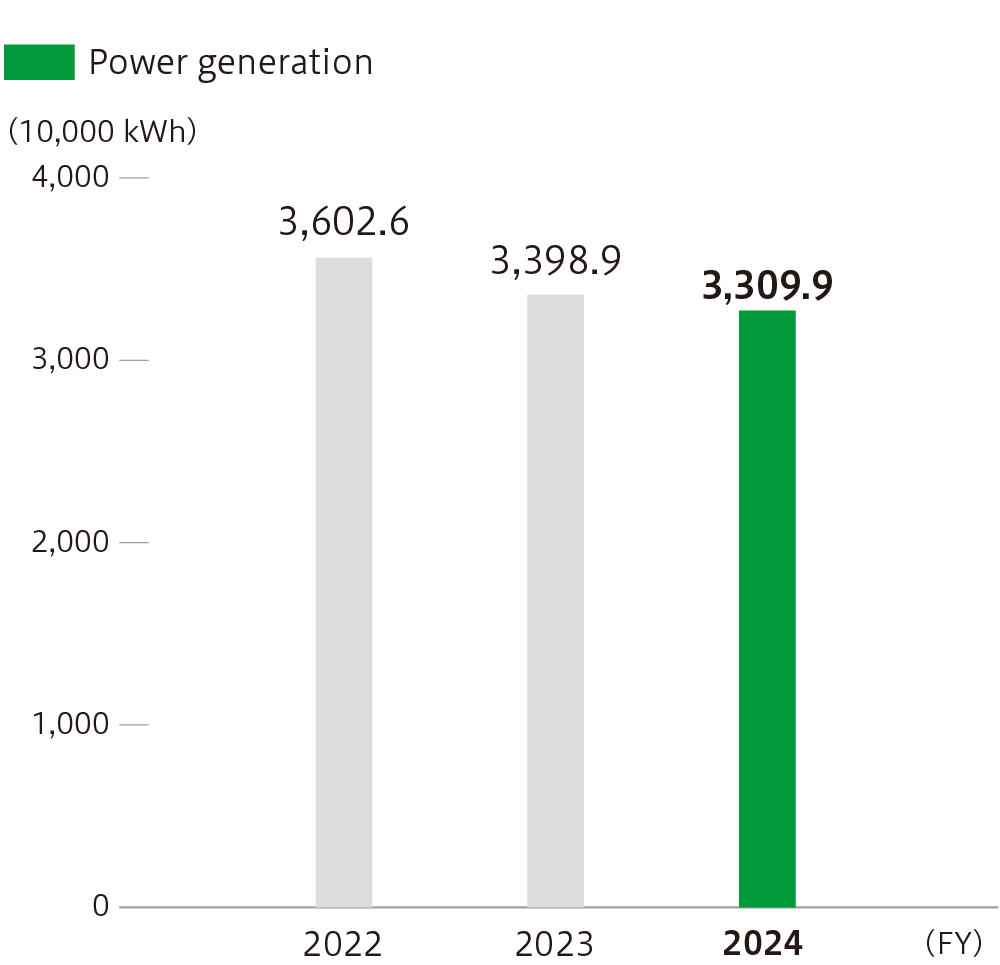Sustainability
- HOME>
- Sustainability>
- E:Environment>
- Preventing global warming
Preventing global warming
Perspective on preventing global warming
As one of the materialities (important issues), we identified contributing to carbon neutrality and will actively work on the control and reduction of CO2 emissions. In addition, we will actively work to improve, reduce, and curb energy use as one measure to promote CO2 reduction.
Total energy and carbon dioxide (CO2) emissions related to our domestic business
We strive to reduce CO2 emissions through the efficient use of energy in our domestic business activities. By switching to energy-efficient equipment, we aim to reduce energy consumption and reduce Scope 1 and 2 CO2 emissions as follows compared to 2013.
・Target fiscal year 2026 23% reduction
・Target fiscal year 2030 46% reduction
-
Our total CO2 emissions
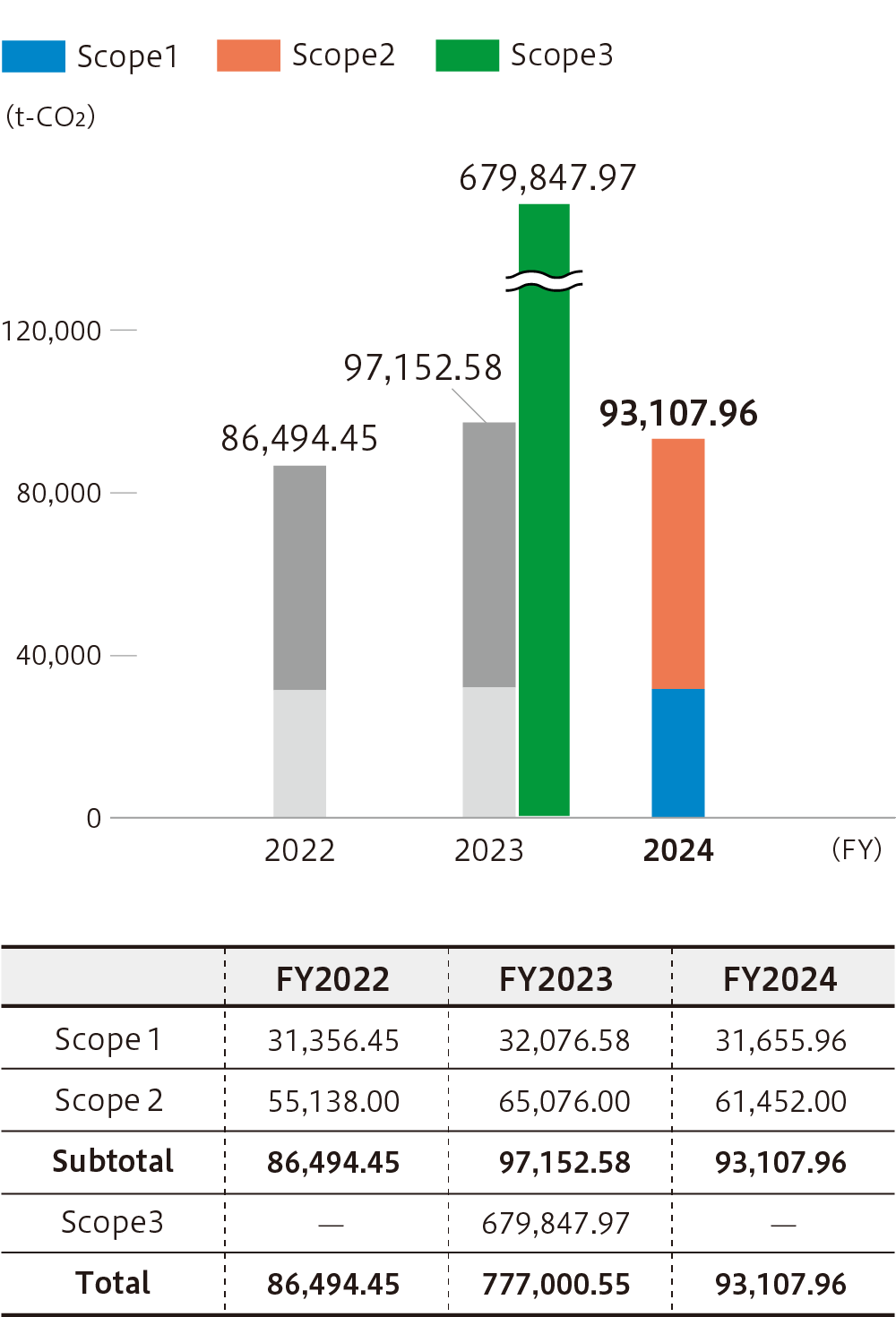
-
Our total energy use (Scope 1, Scope 2 only)
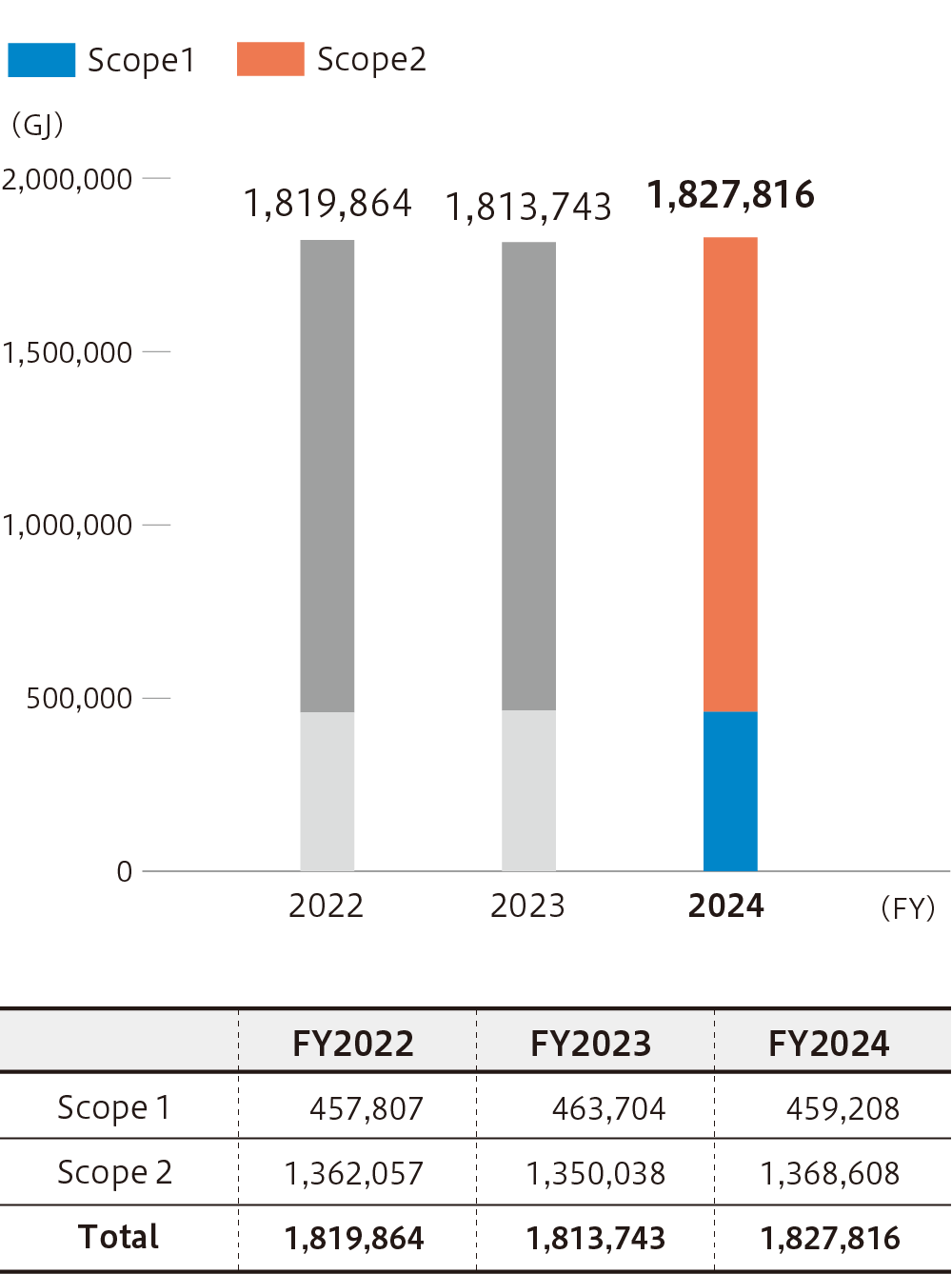
Climate change-related results
Breakdown of Scope 3 CO2 emissions (FY2023)
| Emissions (t-CO2e) | |||
|---|---|---|---|
| Category 1: Purchased Goods and Services | 635,149.19 | Category 9: Downstream Transportation and Distribution | Not applicable |
| Category 2: Capital Goods | 21,486.18 | Category 10: Processing of Sold Products | Not applicable |
| Category 3: Fuel-and Energy-Related Activities Not Included in Scope 1 or Scope 2 | 9,483.68 | Category 11: Use of Sold Products | Not applicable |
| Category 4: Upstream Transportation and Distribution | - | Category 12: End-of-Life Treatment of Sold Products | - |
| Category 5: Waste Generated in Operations | 4,241.19 | Category 13: Downstream Leased Assets | 7,139.80 |
| Category 6: Business Travel | 544.96 | Category 14: Franchises | Not applicable |
| Category 7: Employee Commuting | 1,802.96 | Category 15: Investments | Not applicable |
| Category 8: Upstream Leased Assets | Not applicable | Scope 3 total | 679,847.97 |
| Emissions (t-CO2e) | |
|---|---|
| Category 1: Purchased Goods and Services | 635,149.19 |
| Category 2: Capital Goods | 21,486.18 |
| Category 3: Fuel-and Energy-Related Activities Not Included in Scope 1 or Scope 2 | 9,483.68 |
| Category 4: Upstream Transportation and Distribution | - |
| Category 5: Waste Generated in Operations | 4,241.19 |
| Category 6: Business Travel | 544.96 |
| Category 7: Employee Commuting | 1,802.96 |
| Category 8: Upstream Leased Assets | Not applicable |
| Category 9: Downstream Transportation and Distribution | Not applicable |
| Category 10: Processing of Sold Products | Not applicable |
| Category 11: Use of Sold Products | Not applicable |
| Category 12: End-of-Life Treatment of Sold Products | - |
| Category 13: Downstream Leased Assets | 7,139.80 |
| Category 14: Franchises | Not applicable |
| Category 15: Investments | Not applicable |
| Scope 3 total | 679,847.97 |
Notes:
- *Emission intensity was calculated using the following:
·Ministry of the Environment “Emissions Intensity Database for Calculating Greenhouse Gas Emissions and Other Emissions of Organizations Through Supply Chains (Ver.3.4)”
·IDEA (Ver. 2.3) - *Calculated for domestic operations in Japan
- Calculated in accordance with the GHG Protocol
- The calculation period is from April 2023 to March 2024.
- *Category 1 is calculated by assigning the 26 types of departmental purchase items from the FY2023 payment database.
Breakdown of Scope 3 (%)
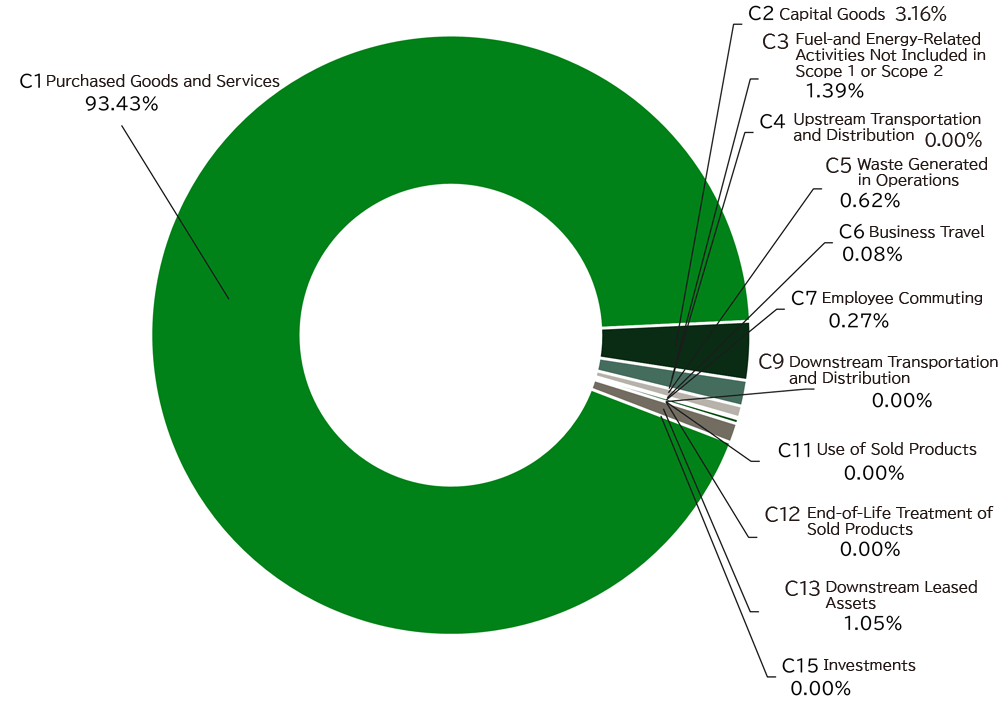
Notes:
- *Categories 4 and 12 are currently uncalculated due to difficulties in data collection.
- *Category 8 includes vehicle leases, but fuel is accounted for under Scope 1.
- *Category 9, we do not sell products, so there is no related transportation and delivery.
- *Category 10, we do not sell products, so there is no processing of sold products.
- *Category 11, we do not sell products, so there are no emissions when they are used.
Managing CFCs
We use refrigeration and freezer equipment to store cargo requiring low temperature management.
Refrigeration and freezer equipment requires CFC gas coolant. In addition to periodic equipment inspections, we perform equipment maintenance and repairs in accordance with the provisions of the Act on Rational Use and Proper Management of Fluorocarbons. We also submit annual records of these activities and reports on leak volumes to the relevant authorities.
Promoting eco-friendly driving
We promote eco-friendly driving. At all of our branch offices in Japan, one individual is appointed to promote eco-friendly driving efforts. This individual administers training and guidance on eco-friendly driving when employees need to drive company vehicles and checks tachographs to manage and supervise driving.
Adopting energy-conserving and low pollutant vehicles
As one measure to help prevent global warming, we purchase vehicles characterized by low levels of pollution and fuel consumption.
Energy conservation activities in offices, warehouses, and other facilities
We implement the Cool Biz and Warm Biz activities recommended by the Ministry of the Environment of Japan to encourage employees to wear clothing that will help us reduce energy use. We set office thermostats to roughly 28°C during the summer months (May-September) and to 20°C in the winter months (November-March).
We also stagger lighting to the extent not to impede business operations and shut off lights in rooms that are not in use and during lunch breaks.
-
Electricity use
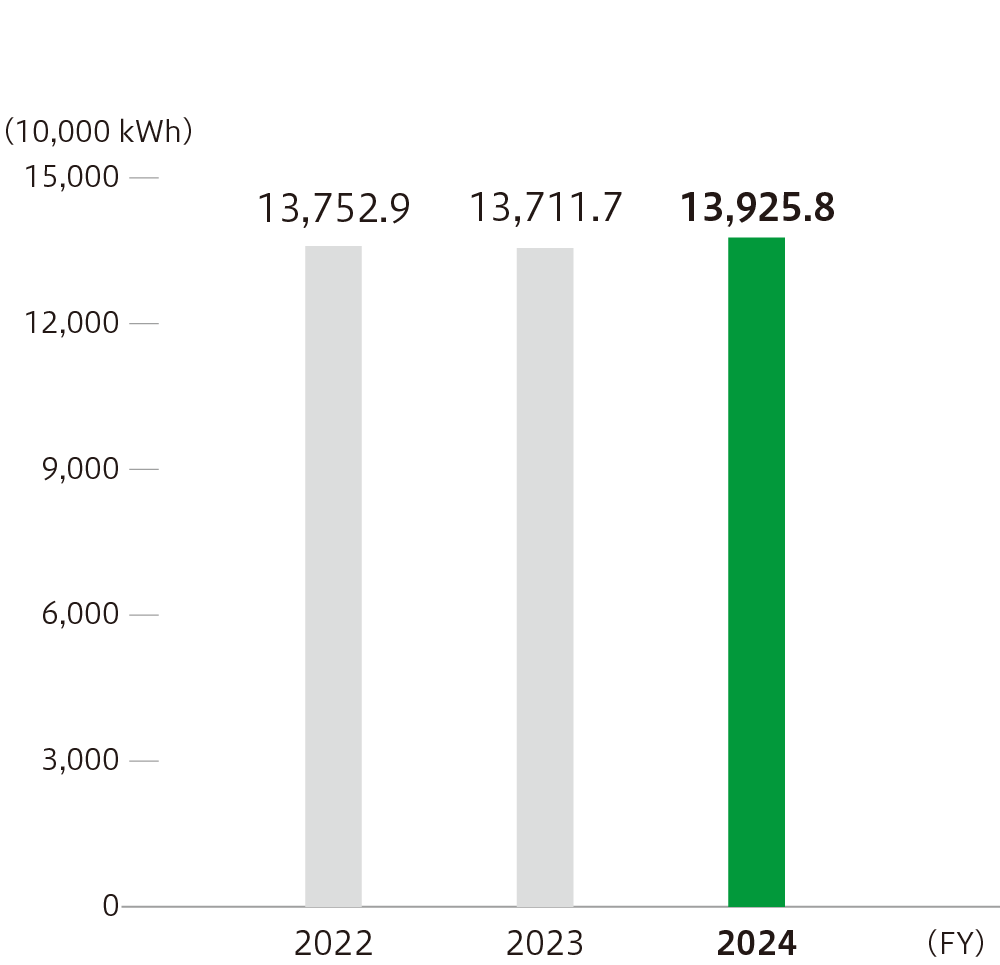
Switching to LED lighting
We're making steady progress toward switching to LED lighting in our offices and warehouses to conserve energy and reduce CO2emissions.
Electricity sale business using solar power generation
We have solar power generation facilities (capacity: 2.95 MkW) on the rooftops of our warehouses and on land we own, which generated approximately 33 million kWh in FY2024.
-
Power generation from sunlight
